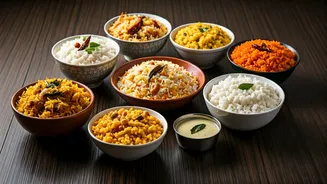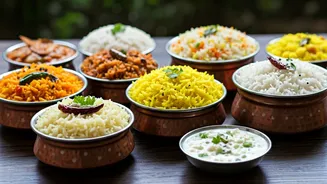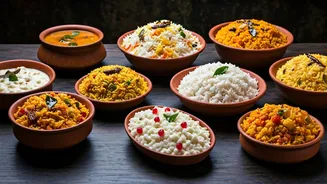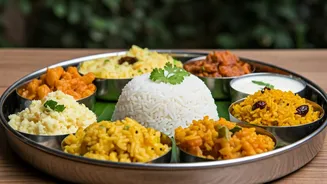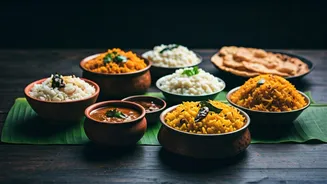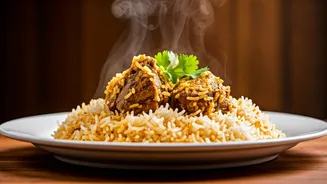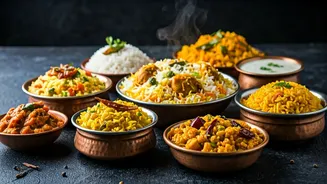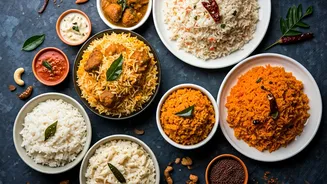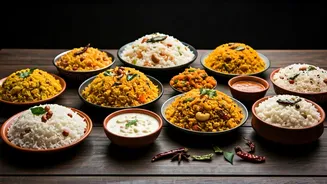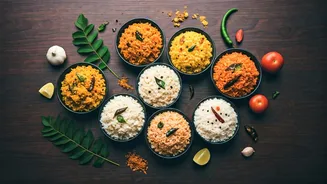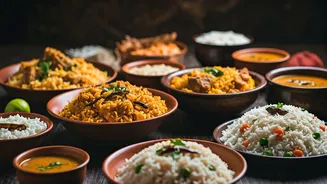Introduction to Rice
Rice is a staple food across South India, and its versatility shines through in numerous dishes. From the delicate idli and dosa, which are part of breakfast
in South India, to elaborate biryanis, rice forms the foundation of a varied culinary landscape. Each region in the south adds its own unique touch, using local ingredients and cooking styles to elevate the humble grain. The methods employed, whether steaming, frying, or slow-cooking, showcase the artistry and innovation of South Indian chefs, resulting in a spectrum of flavors and textures. The cultural significance of rice also adds another dimension, often associated with celebrations and communal gatherings, making the dishes not just food, but symbols of tradition and heritage.
1. Biryani Bliss
Biryani, a rice dish that is loved throughout India, has several regional variations in the South. Whether it is Hyderabadi biryani or the Tamil Nadu style biryani, each has a distinctive taste profile. Prepared with marinated meat (usually chicken or mutton), fragrant spices like saffron and cardamom, and long-grain basmati rice, biryani is slow-cooked to perfection. The layering technique, in which the rice and meat are cooked together, infuses the rice with the rich flavors of the other ingredients. Biryani is a celebration of flavors and is often served during special occasions, bringing people together around a table filled with aromas and deliciousness. This dish reflects the influence of Mughal and other culinary traditions, which have been blended with the local ingredients and techniques to create a unique culinary experience.
2. Lemon Rice Zest
Lemon rice, or chitranna, is a refreshing dish prepared in South India. It is a quick and simple rice dish seasoned with lemon juice, mustard seeds, urad dal, and curry leaves. It's a culinary treat, perfect for a light lunch or a snack. The tanginess of the lemon perfectly complements the other flavors, creating a dish that is light yet satisfying. This versatile dish is often customized with different vegetables or nuts. It is a perfect example of how simple ingredients can be combined to produce a flavor-packed experience. This is popular in the region and is a testament to the cuisine's ability to create dishes that are easy to make and delicious to eat.
3. Tomato Rice Temptation
Tomato rice is another simple yet flavorful rice dish common in South Indian homes. Cooked with ripe tomatoes, onions, and aromatic spices, it provides a balance of tang and spice. This dish is usually made in a pressure cooker or pot, making it an easy option for busy days. The vibrant color and taste of tomatoes combined with spices create a satisfying meal. Tomato rice is often served with raita or papadum. It reflects the region’s use of fresh, locally sourced produce. It is a hearty and delightful dish and a staple for many people.
4. Coconut Rice Delight
Coconut rice, or thengai sadam, is a fragrant and flavorful dish prepared with grated coconut and tempered with spices. This dish uses the creamy texture of coconut, combining it with the spices of South India. The sweetness of the coconut is balanced by the spice of mustard seeds and chilies. The dish can also be customized with vegetables. Coconut rice is a popular choice for festivals and special occasions. It showcases the richness and freshness of the region's culinary techniques and ingredients, reflecting its close relationship with the natural bounty of the land. Its simple preparation method helps make it a favorite for all generations.
5. Tamarind Rice Magic
Tamarind rice, also known as puliyodarai, is a tangy and flavorful rice dish. Tamarind is the main ingredient and it gives the dish a sour taste, enhanced by spices like asafoetida, chilies, and mustard seeds. It is a dish that has a beautiful balance of tanginess, spice, and aroma, making it a favorite in South Indian homes. The dish has a long shelf life and is often prepared for travel or as a picnic item. The dish reflects the region's culinary tradition, emphasizing the use of local fruits and spices. Its simplicity and long-lasting nature highlight the practical and delightful aspects of South Indian cooking.
6. Curd Rice Comfort
Curd rice, or thayir sadam, is a cooling and soothing dish that is commonly eaten at the end of a meal. Prepared by mixing cooked rice with curd or yogurt, it is tempered with mustard seeds and curry leaves. This simple dish is a good option when you want something light and easy to digest. It also adds a nice, cooling effect to the meal. Curd rice is often eaten with pickles or chutneys, providing a perfect balance of flavors and textures. It exemplifies the simplicity and approachability of South Indian cuisine, highlighting the harmony between tradition and everyday eating habits. It is a staple that provides comfort and a taste of home, making it a favored choice.
7. Pongal Perfection
Pongal, a rice-based dish made with lentils, is a popular breakfast dish from South India, particularly during the Pongal harvest festival. It comes in two varieties: sweet pongal and savory pongal. Sweet pongal is prepared with rice, lentils, jaggery, and ghee, while savory pongal includes rice, lentils, spices, and vegetables. Both options are a celebration of taste and tradition, often served during festivals and special occasions. The preparation of pongal is a community activity that symbolizes the blessings of the harvest. It showcases the rich cultural heritage and culinary skills of South India. The dish represents the agricultural foundation of the region, creating a festive spirit.
8. Variety Rice Roundup
Apart from the dishes, South Indian cuisine also boasts a variety of other rice preparations. These dishes combine rice with different ingredients, flavors, and cooking methods. From the spiced flavors of vegetable rice to the unique character of bisi bele bath, there is a wide range to explore. Each of these variations reflects the regional influences and culinary innovation that defines South Indian cooking. The broad selection of rice dishes allows for culinary experimentation and is a symbol of South India's culinary adaptability and inventiveness. These dishes showcase the region's rich diversity in ingredients, cooking methods, and flavor combinations, appealing to a wide range of tastes.
